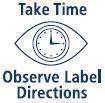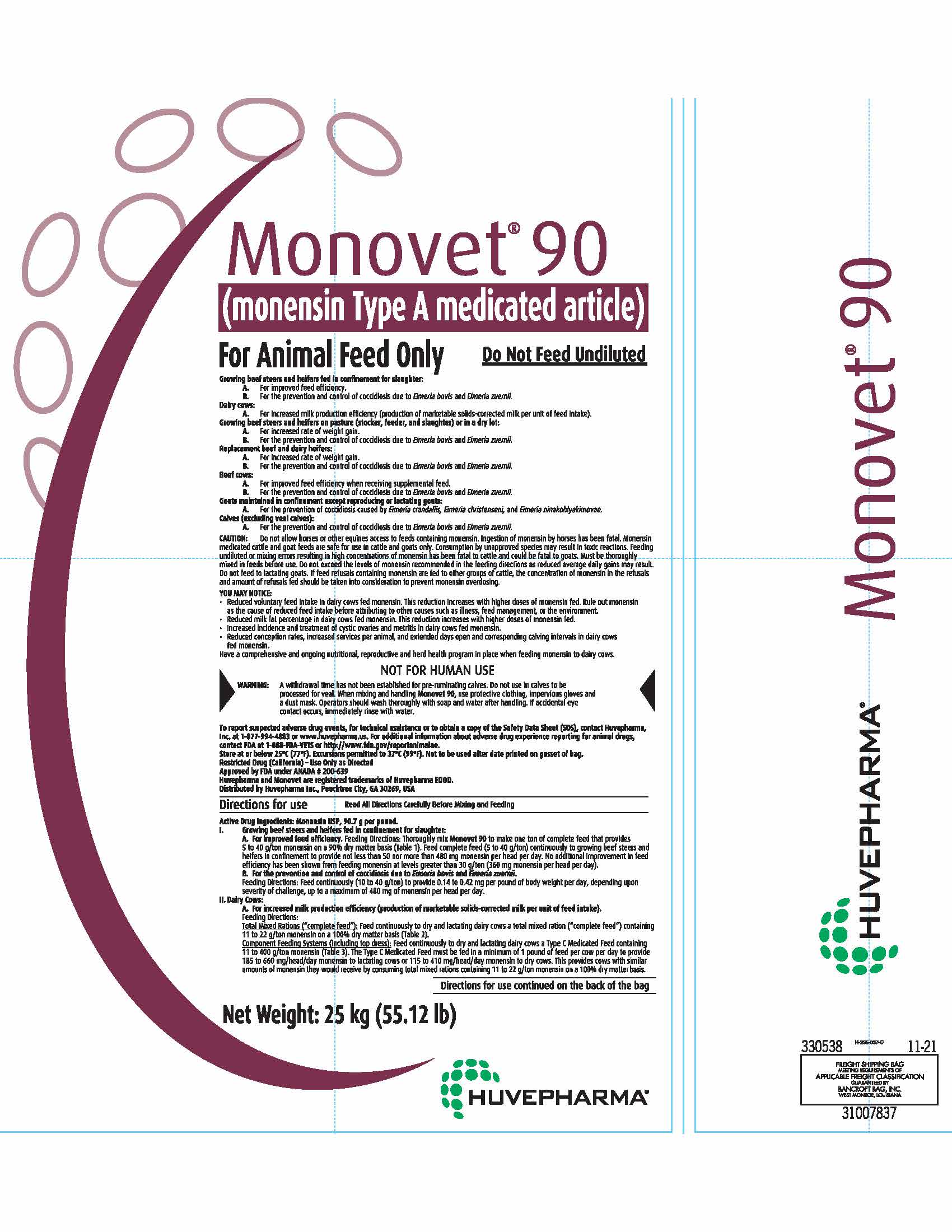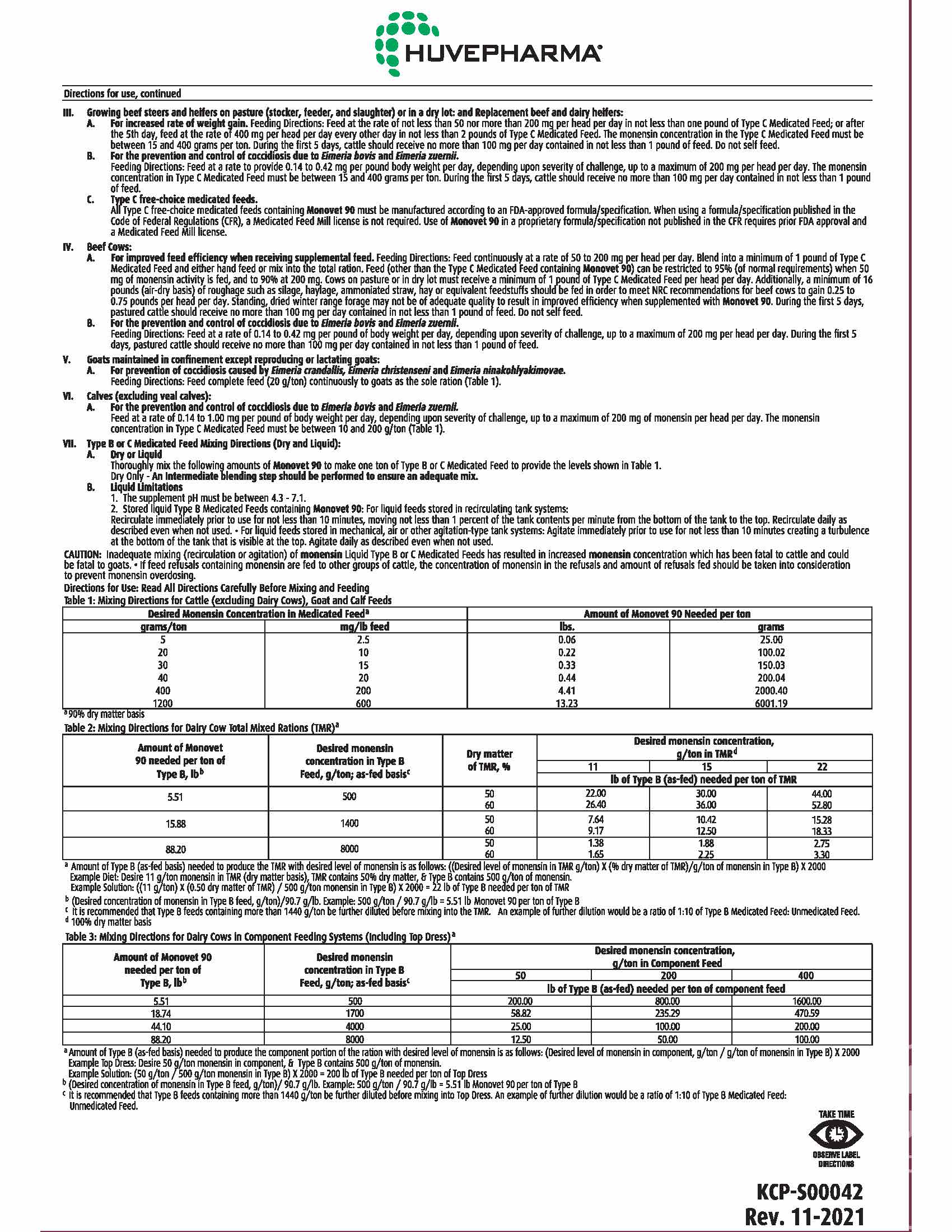Animal NDC 23243-0064-5 Monovet 90
Monensin
Animal Product Information
| Field Name | Field Value |
|---|---|
| Animal NDC Code | 23243-0064-5 |
| Proprietary Name | Monovet 90 What is the Proprietary Name? The proprietary name also known as the trade name is the name of the product chosen by the medication labeler for marketing purposes. |
| Non-Proprietary Name | Monensin What is the Non-Proprietary Name? The non-proprietary name is sometimes called the generic name. The generic name usually includes the active ingredient(s) of the product. |
| Labeler Name | Huvepharma, Inc. |
| Product Type | Otc Type A Medicated Article Animal Drug |
| Usage Information |
|
| Active Ingredient(s) |
|
| Marketing Category | ANADA - ABBREVIATED NEW ANIMAL DRUG APPLICATION What is the Marketing Category? Product types are broken down into several potential Marketing Categories, such as NDA/ANDA/BLA, OTC Monograph, or Unapproved Drug. One and only one Marketing Category may be chosen for a product, not all marketing categories are available to all product types. Currently, only final marketed product categories are included. The complete list of codes and translations can be found at www.fda.gov/edrls under Structured Product Labeling Resources. |
| FDA Application Number | ANADA200639 What is the FDA Application Number? This corresponds to the NDA, ANDA, or BLA number reported by the labeler for products which have the corresponding Marketing Category designated. If the designated Marketing Category is OTC Monograph Final or OTC Monograph Not Final, then the Application number will be the CFR citation corresponding to the appropriate Monograph (e.g. “part 341”). For unapproved drugs, this field will be null. |
Monovet 90 Images
Monovet 90 Animal Product Labeling Information
The product labeling information includes all published material associated to a drug. Product labeling documents include information like generic names, active ingredients, ingredient strength dosage, routes of administration, appearance, usage, warnings, inactive ingredients, etc.
Table of Contents
Directions For Use Read All Directions Carefully Before Mixing And Feeding
Active Drug Ingredients: Monensin USP, 90.7 g per pound.
I. Growing beef steers and heifers fed in confinement for slaughter:
A. For improved feed efficiency. Feeding Directions: Thoroughly mix Monovet 90 to make one
ton of complete feed that provides 5 to 40 g/ton monensin on a 90% dry matter basis (Table 1).
Feed complete feed (5 to 40 g/ton) continuously to growing beef steers and heifers in
confinement to provide not less than 50 nor more than 480 mg monensin per head per day. No
additional improvement in feed efficiency has been shown from feeding monensin at levels greater
than 30 g/ton (360 mg monensin per head per day).
B. For the prevention and control of coccidiosis due to Eimeria bovis and Eimeria zuernii.
Feeding Directions: Feed continuously (10 to 40 g/ton) to provide 0.14 to 0.42 mg per pound of
body weight per day, depending upon severity of challenge, up to a maximum of 480 mg of
monensin per head per day.
II. Dairy Cows:
A. For increased milk production efficiency (production of marketable solids-corrected milk
per unit of feed intake).
Feeding Directions:
Total Mixed Rations (“complete feed”): Feed continuously to dry and lactating dairy cows a total mixed ration
(“complete feed”) containing 11 to 22 g/ton monensin on a 100% dry matter basis (Table 2).
Component Feeding Systems (including top dress): Feed continuously to dry and lactating dairy cows a Type C
Medicated Feed containing 11 to 400 g/ton monensin (Table 3). The Type C Medicated Feed must be
fed in a minimum of 1 pound of feed per cow per day to provide 185 to 660 mg/head/day monensin
to lactating cows or 115 to 410 mg/head/day monensin to dry cows. This provides cows with similar
amounts of monensin they would receive by consuming total mixed rations containing 11 to 22 g/ton
monensin on a 100% dry matter basis.
Directions for use continued on the back of the bag
Net Weight: 25 kg (55.12 lb)
Directions For Use, Continued
III. Growing beef steers and heifers on pasture (stocker, feeder, and slaughter) or in a dry lot: and
Replacement beef and dairy heifers:
A. For increased rate of weight gain. Feeding Directions: Feed at the rate of not less than 50 nor more
than 200 mg per head per day in not less than one pound of Type C Medicated Feed; or after the 5th
day, feed at the rate of 400 mg per head per day every other day in not less than 2 pounds of Type C
Medicated Feed. The monensin concentration in the Type C Medicated Feed must be between 15 and 400
grams per ton. During the first 5 days, cattle should receive no more than 100 mg per day contained
in not less than 1 pound of feed. Do not self feed.
B. For the prevention and control of coccidiosis due to Eimeria bovis and Eimeria zuernii.
Feeding Directions: Feed at a rate to provide 0.14 to 0.42 mg per pound body weight per day,
depending upon severity of challenge, up to a maximum of 200 mg per head per day. The monensin
concentration in Type C Medicated Feed must be between 15 and 400 grams per ton. During the first
5 days, cattle should receive no more than 100 mg per day contained in not less than 1 pound of feed.
C. Free-Choice (Self-Fed) Medicated Feeds.
All Type C free-choiee medicated leeds containing Monovet 90 must be manufactured according
to an FDA-approved formula/specification published in the Code of Federal Regulation (CFR),
a Medicated Feed Mill license is not required. Use of Monovet 90 in a proprietary
formula/specification not published in the CFR requires prior FDA approval and a Medicated
Feed Mill license.
IV. Beef Cows:
A. For improved feed efficiency when receiving supplemental feed.
Feeding Directions: Feed continuously at a rate of 50 to 200 mg per head per day. Blend into a minimum
of 1 pound of Type C Medicated Feed and either hand feed or mix into the total ration. Feed (other than
the Type C Medicated Feed containing Monovet 90) can be restricted to 95% (of normal requirements)
when 50 mg of monensin activity is fed, and to 90% at 200 mg. Cows on pasture or in dry lot must receive
a minimum of 1 pound of Type C Medicated Feed per head per day. Additionally, a minimum of 16 pounds
(air-dry basis) of roughage such as silage, haylage, ammoniated straw, hay or equivalent feedstuffs should
be fed in order to meet NRC recommendations for beef cows to gain 0.25 to 0.75 pounds per head per day.
Standing, dried winter range forage may not be of adequate quality to result in improved efficiency when
supplemented with Monovet 90. During the first 5 days, pastured cattle should receive no more than 100
mg per day contained in not less than 1 pound of feed. Do not self feed.
B. For the prevention and control of coccidiosis due to Eimeria bovis and Eimeria zuernii.
Feeding Directions: Feed at a rate of 0.14 to 0.42 mg per pound of body weight per day, depending
upon severity of challenge, up to a maximum of 200 mg per head per day. During the first 5 days,
pastured cattle should receive no more than 100 mg per day contained in not less than 1 pound of feed.
V. Goats maintained in confinement except reproducing or lactating goats:
A.For prevention of coccidiosis caused by Eimeria crandallis, Eimeria christenseni and Eimeria
ninakohlyakimovae.
Feeding Directions: Feed complete feed (20 g/ton) continuously to goats as the sole ration (Table 1).
VI. Calves (excluding veal calves):
A. For the prevention and control of coccidiosis due to Eimeria bovis and Eimeria zuernii.
Feed at a rate of 0.14 to 1.00 mg per pound of body weight per day, depending upon severity of challenge,
up to a maximum of 200 mg of monensin per head per day. The monensin concentration in Type C Medicated
Feed must be between 10 and 200 g/ton (Table 1).
VII. Type B or C Medicated Feed Mixing Directions (Dry and Liquid):
A. Dry or Liquid
Thoroughly mix the following amounts of Monovet 90 to make one ton of Type B or C Medicated Feed to
provide the levels shown in Table 1.
Dry Only - An Intermediate blending step should be performed to ensure an adequate mix.
B. Liquid Limitations
1. The supplement pH must be between 4.3 - 7.1.
2. Stored liquid Type B Medicated Feeds containing Monovet 90: For liquid feeds stored in recirculating
tank systems: Recirculate immediately prior to use for not less than 10 minutes, moving not less than
1 percent of the tank contents per minute from the bottom of the tank to the top. Recirculate daily as
described even when not used. • For liquid feeds stored in mechanical, air or other agitation-type tank
systems: Agitate immediately prior to use for not less than 10 minutes creating a turbulence at the
bottom of the tank that is visible at the top. Agitate daily as described even when not used.
General Precautions
CAUTION: Inadequate mixing (recirculation or agitation) of monensin Liquid Type B or C Medicated Feeds has resulted
in increased monensin concentration which has been fatal to cattle and could be fatal to goats. • If feed refusals
containing monensin are fed to other groups of cattle, the concentration of monensin in the refusals and amount of
refusals fed should be taken into consideration to prevent monensin overdosing.
Directions For Use: Read All Directions Carefully Before Mixing And Feeding
| Desired Monensin Concentration in Medicated Feeda | Amount of Monovet 90 Needed per ton | ||
| grams/ton | mg/lb feed | lbs. | grams |
| 5 | 2.5 | 0.06 | 25.00 |
| 20 | 10 | 0.22 | 100.02 |
| 30 | 15 | 0.33 | 150.03 |
| 40 | 20 | 0.44 | 200.04 |
| 400 | 200 | 4.41 | 2000.40 |
| 1200 | 600 | 13.23 | 6001.19 |
| a 90% dry matter basis | |||
| Amount of Monovet 90 needed per ton of Type B, lbb | Desired monensin concentration in Type B Feed, g/ton; as-fed basisc | Dry Matter of TMR, % | Desired monensin concentration, g/ton in TMRd | ||
| 11 | 15 | 22 | |||
| lb of Type B (as-fed) needed per ton of TMR | |||||
| 5.51 | 500 | 50 60 | 22.00 26.40 | 30.00 36.00 | 44.00 52.80 |
| 15.88 | 1400 | 50 60 | 7.64 9.17 | 10.42 12.50 | 15.28 18.33 |
| 88.20 | 8000 | 50 60 | 1.38 1.65 | 1.88 2.25 | 2.75 3.30 |
a Amount of Type B (as-fed basis) needed to produce the TMR with desired level of monensin is as follows: ((Desired level of monensin in TMR g/ton) X (% dry matter of TMR)/g/ton of monensin in Type B) X 2000
Example Diet: Desire 11 g/ton monensin in TMR (dry matter basis), TMR contains 50% dry matter, & Type B contains 500 g/ton of monensin.
Example Solution: ((11 g/ton) X (0.50 dry matter of TMR) / 500 g/ton monensin in Type B) X 2000 = 22 lb of Type B needed per ton of TMR
b (Desired concentration of monensin in Type B feed, g/ton)/90.7 g/lb. Example: 500 g/ton / 90.7 g/lb = 5.51 lb Monovet 90 per ton of Type B
c It is recommended that Type B feeds containing more than 1440 g/ton be further diluted before mixing into the TMR. An example of further dilution would be a ratio of 1:10 of Type B Medicated Feed: Unmedicated Feed.
d 100% dry matter basis
Amount of Monovet 90 needed per ton of Type B, lb b | Desired monensin concentration in Type B Feed, g/ton; as-fed basisc | Desired monensin concentration, g/ton in Component Feed | ||
| 50 | 200 | 400 | ||
| lb of Type B (as-fed) needed per ton of component feed | ||||
| 5.51 | 500 | 200.00 | 800.00 | 1600.00 |
| 18.74 | 1700 | 58.82 | 235.29 | 470.59 |
| 44.10 | 4000 | 25.00 | 100.00 | 200.00 |
| 88.20 | 8000 | 12.50 | 50.00 | 100.00 |
a Amount of Type B (as-fed basis) needed to produce the component portion of the ration with desired level of monensin is as follows: (Desired level of monensin in component, g/ton / g/ton of monensin in Type B) X 2000
Example Top Dress: Desire 50 g/ton monensin in component, & Type B contains 500 g/ton of monensin.
Example Solution: (50 g/ton / 500 g/ton monensin in Type B) X 2000 = 200 lb of Type B needed per ton of Top Dress
b (Desired concentration of monensin in Type B feed, g/ton)/ 90.7 g/lb. Example: 500 g/ton / 90.7 g/lb = 5.51 lb Monovet 90 per ton of Type B
c It is recommended that Type B feeds containing more than 1440 g/ton be further diluted before mixing into Top Dress. An example of further dilution would be a ratio of 1:10 of Type B Medicated Feed:
Unmedicated Feed.
Take Time
KCP-S00042
Rev. 11-2021
Bag Front
Net Weight: 25 kg (55.12 lbs)
Huvepharma®
* The information on this page is for an ANIMAL PRODUCT, please review the complete disclaimer below.


